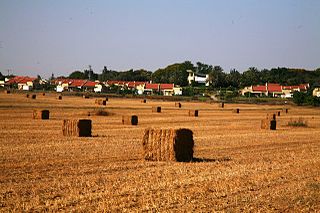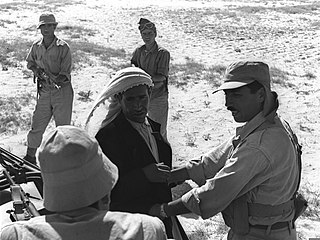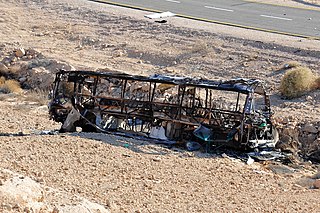The history of the Israel Defense Forces (IDF) intertwines in its early stages with history of the Haganah.

The 1st "Golani" Brigade is an Israeli military infantry brigade. It is subordinated to the 36th Division and traditionally associated with the Northern Command. It is one of the five infantry brigades of the regular Israel Defense Forces (IDF), the others being the Paratroopers Brigade, the Nahal Brigade, the Givati Brigade and the Kfir Brigade. Its symbol is a green olive tree against a yellow background, with its soldiers wearing a brown beret. It is one of the most highly decorated infantry units in the IDF. The brigade consists of five battalions, including two which it kept from its inception, one transferred from the Givati Brigade (51st).
This page is a partial listing of incidents of violence in the Israeli-Palestinian conflict in 2004.
This page is a partial listing of incidents of violence in the Israeli-Palestinian conflict in 2005.

Alumim is a religious kibbutz located in the northwestern Negev desert in southern Israel, near the Gaza Strip. It falls under the jurisdiction of Sdot Negev Regional Council.

Palestinian return to Israel refers to the movement of Palestinians back into the territory of present Israel.

The Ras Burqa massacre was a mass shooting on 5 October 1985 on Israeli vacationers in Ras Burqa, a beach resort area in the Sinai peninsula, in which seven people, including four children, were killed by Egyptian soldier Suleiman Khater.

October 1956 was the tenth month of that leap year. The month which began on a Monday and ended after 31 days on a Wednesday

Palestinian fedayeen are militants or guerrillas of a nationalist orientation from among the Palestinian people. Most Palestinians consider the fedayeen to be "freedom fighters", while most Israelis consider them to be "terrorists".
The following is a partial list of civilian casualties in the Second Intifada.

In 2008, Israel sought to halt the rocket and mortar fire from Gaza that killed four Israeli civilians that year and caused widespread trauma and disruption of life in Israeli towns and villages close to the Gaza border. In addition, Israel insisted that any deal include an end to Hamas's military buildup in Gaza, and movement toward the release of Corporal Gilad Shalit. Hamas wanted an end to the frequent Israeli military strikes and incursions into Gaza, and an easing of the economic blockade that Israel has imposed since Hamas took over the area in 2007.
Events in the year 1956 in Israel.
Events in the year 1955 in Israel.
The Yehud attack was an attack on a civilian house in the village of Yehud carried out by a Palestinian fedayeen squad on 12 October 1953. Three Israeli Jewish civilians, a mother and her infant children, were killed in the attack.
The Ein Ofarim killings was an attack by Palestinian Fedayeen, which occurred on Wednesday night, 12 September 1956.

On August 18, 2011, a series of cross-border attacks with parallel attacks and mutual cover was carried out in southern Israel on Highway 12 near the Egyptian border by a squad of presumably twelve militants in four groups. The attacks occurred after Israel's interior security service Shin Bet had warned of an attack by militants in the region and Israeli troops had been stationed in the area. The militants first opened fire at an Egged No. 392 bus as it was traveling on Highway 12 in the Negev near Eilat. Several minutes later, a bomb was detonated next to an Israeli army patrol along Israel's border with Egypt. In a third attack, an anti-tank missile hit a private vehicle, killing four civilians. Eight Israelis – six civilians, one Yamam special unit police sniper and one Golani Brigade soldier—were killed in the multiple-stage attack. The Israel Defense Forces reported eight attackers killed, and Egyptian security forces reported killing another two.
The Misgav Am hostage crisis, which began during the night of April 7, 1980, was a raid carried out by a squad of five Palestinian militants belonging to the Iraqi-backed Arab Liberation Front militant organization, on the northern Israeli kibbutz of Misgav Am in which the militants captured a group of toddlers and babies in the children's sleeping quarters of the kibbutz and held them as hostages. The event ended the next day with the takeover of the terrorist stronghold by Israeli special forces.
The murder of the Aroyo children was a terrorist attack which occurred on 2 January 1971, in which two Israeli children were killed when Palestinian militants threw a hand grenade into the moving car of the Aroyo family which was touring the Gaza Strip. The attack was a turning point in the way Israel began relating towards terrorist threats originating from the Gaza Strip. Following the attack Israel launched an extensive counter-terror operation in the Gaza Strip.
The 2004 IDF outpost bombing attack was an integrated attack carried out on 12 December 2004 by a Palestinian militant squad of the Izz al-Din al-Qassam military wing of Hamas and the Fatah Hawks at an Israel Defense Forces outpost located on the border between the Gaza Strip and Egypt.








